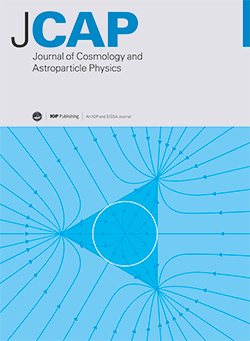Heating the dark matter halo with dark radiation from supernovae
IF 5.3
2区 物理与天体物理
Q1 ASTRONOMY & ASTROPHYSICS
Journal of Cosmology and Astroparticle Physics
Pub Date : 2025-07-17
DOI:10.1088/1475-7516/2025/07/058
引用次数: 0
Abstract
Supernova explosions are among the most extreme events in the Universe, making them a promising environment in which to search for the effects of light, weakly coupled new particles. As significant sources of energy, they are known to have an important effect on the dynamics of ordinary matter in their host galaxies but their potential impact on the dark matter (DM) halo remains less explored. In this work, we investigate the possibility that some fraction of the supernova energy is released via the form of dark radiation into the DM halo. Based on evaluation of energetics, we find that even a small fraction of the total SN energy is sufficient to change the overall shape of the DM halo and transform a cuspy halo into a cored one. This may help to explain the cores that are observed in some dwarf galaxies. Alternatively, one can interpret the upper limit on the size of a possible DM core as an upper limit on the energy that can go into light particles beyond the SM. These arguments are largely independent of a concrete model for the new physics. Nevertheless, it is important to ensure that the conditions we need, i.e. significant supernova emissivity of dark radiation and the opacity of DM halo to the dark radiation, can be met in actual models. To demonstrate this, we study four simple benchmark models: the dark photon, dark Higgs, and gauged B-L and Lμ - Lτ models — all provide light weakly coupled particles serving as the dark radiation. Assuming a sizable coupling of the dark radiation to DM, we find that all of the benchmark models have a significant part of the parameter space that meets the conditions. Interestingly, the couplings allowed by observations of SN1987A can have a significant effect on the halo of dwarf spheroidal galaxies.用超新星的暗辐射加热暗物质光晕
超新星爆炸是宇宙中最极端的事件之一,使它们成为一个有希望的环境,在其中寻找光的影响,弱耦合的新粒子。作为重要的能量来源,已知它们对宿主星系中普通物质的动力学有重要影响,但它们对暗物质(DM)晕的潜在影响仍未被探索。在这项工作中,我们研究了超新星能量的一部分通过暗辐射的形式释放到DM光晕中的可能性。基于能量学的评价,我们发现即使是SN总能量的一小部分也足以改变DM晕的整体形状,将cuspy晕转变为芯状晕。这可能有助于解释在一些矮星系中观察到的核心。或者,我们可以将DM核心的上限解释为进入SM之外的轻粒子的能量上限。这些论点在很大程度上与新物理学的具体模型无关。然而,重要的是要确保在实际模型中能够满足我们需要的条件,即显著的超新星暗辐射发射率和DM晕对暗辐射的不透明度。为了证明这一点,我们研究了四种简单的基准模型:暗光子,暗希格斯,以及测量的B-L和Lμ - Lτ模型,它们都提供了光弱耦合粒子作为暗辐射。假设暗辐射与DM有相当大的耦合,我们发现所有基准模型的参数空间都有显著部分满足条件。有趣的是,SN1987A观测所允许的耦合可以对矮球状星系的光晕产生重大影响。
本文章由计算机程序翻译,如有差异,请以英文原文为准。
求助全文
约1分钟内获得全文
求助全文
来源期刊

Journal of Cosmology and Astroparticle Physics
地学天文-天文与天体物理
CiteScore
10.20
自引率
23.40%
发文量
632
审稿时长
1 months
期刊介绍:
Journal of Cosmology and Astroparticle Physics (JCAP) encompasses theoretical, observational and experimental areas as well as computation and simulation. The journal covers the latest developments in the theory of all fundamental interactions and their cosmological implications (e.g. M-theory and cosmology, brane cosmology). JCAP''s coverage also includes topics such as formation, dynamics and clustering of galaxies, pre-galactic star formation, x-ray astronomy, radio astronomy, gravitational lensing, active galactic nuclei, intergalactic and interstellar matter.
 求助内容:
求助内容: 应助结果提醒方式:
应助结果提醒方式:


